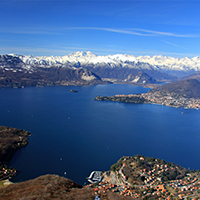Model simulations of the ecological dynamics induced by climate and nutrient load changes for deep subalpine Lake Maggiore (Italy/Switzerland)
Model simulations of the future ecological dynamics of Lake Maggiore

All claims expressed in this article are solely those of the authors and do not necessarily represent those of their affiliated organizations, or those of the publisher, the editors and the reviewers. Any product that may be evaluated in this article or claim that may be made by its manufacturer is not guaranteed or endorsed by the publisher.
Authors
Climate warming affects lake ecosystems both through its direct effect on the phenology of species and through the alteration of the physical and chemical environments, which in turn affect community composition. In deep lakes, stratification enhancement and mixing reduction have already been observed, leading to hypolimnetic anoxia and to the rise of cyanophytes. The increase in stability depends on the rise of air temperature due to global emissions of greenhouse gases (GHG). Primary production could then either increase with rising epilimnetic temperature and buoyancy or decrease as fewer nutrients are upwelled from deep layers. The prevailing outcome, as well as the quantitative and temporal dynamics of all climate-induced modifications, depend on the specific lake characteristics. Individual analyses are then needed, one-dimensional coupled hydrodynamic-ecological numerical models being suitable tools for such predictions. Here, we simulated with GLM-AED2 (General Lake Model – Aquatic EcoDynamics) the 2020-2085 dynamics of the oligomictic and oligotrophic deep subalpine Lake Maggiore (Italy/Switzerland), according to the Swiss Climate Change Scenarios CH2011. Multiple realisations were performed for each scenario with random meteorological series obtained from the Vector-Autoregressive Weather Generator (VG), highlighting the uncertainties related to meteorology. Increase and decrease of nutrient loads were also tested. Results show that anoxia would occur in the hypolimnion regardless of nutrient input reduction, unless global GHG emissions were immediately reduced. Total phytoplankton biomass would be weakly affected by climate change, strongly depending on nutrient input, yet water warming would cause cyanophytes to compete with diatoms. Therefore, the fate of Lake Maggiore would be tied to both global and local environmental policies.







